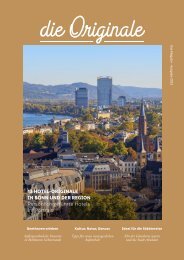LUXAIR_LUXiClub_So12 ls
p o
p
o
You also want an ePaper? Increase the reach of your titles
YUMPU automatically turns print PDFs into web optimized ePapers that Google loves.
Number 43, Fall 2002
cartographic perspectives 47
hemisphere). Shaded relief illuminated from this direction is highly
susceptible to relief inversion, an optical illusion in which mountains
and valleys appear to be inverted. Although it is possible to adjust
embedded shadowing in aerial photographs to counter relief inversion
in relatively flat areas (Rudnicki, 2000), the technique is not applicable
in high mountains.
• Cast shadows - Shadows cast by high, steep terrain often obscure important
information on adjacent slopes and flat areas. They also cause
drainages to appear misregistered with terrain and can disfigure an
image with unsightly dark blotches. Cast shadows are impossible to
remove when their density approaches 100 percent.
• Information overload - Aerial photographs show raw, unfiltered data
in all its confusing glory. Untrained readers may find the minute detail
to be fascinating, but few actually understand what they are seeing.
• Inappropriate information - Do we really need to see parking lots,
power lines, construction sites, and Christo art?
• Invisible information - Small buildings, trails and streams often cannot
be seen through dense forest canopies. Clouds, which tend to persist
over mountainous regions, and their shadows obscure the ground
below.
• No visual hierarchy - From above, a park visitor center and a nearby
sewage treatment facility might appear equally significant.
• Temporal sensitivity - For better or worse, aerial photographs show
us a single moment in time. By the time the map is made, an image
taken of a farm field could have been replaced with suburban homes, a
glacier could have melted, or a winter-bare deciduous forest may be in
leaf.
Notwithstanding these shortcomings, aerial photographs have been
used to produce realistic maps. Most innovative, perhaps, are the South
Pacific island maps, including Aitutaki, Cook Islands, produced by the
New Zealand Department of Survey and Land Information during the
1970s. On the Aitutaki map, terrestrial areas are shown in a competent
and conventional cartographic manner. However, the depiction of water
is unique (Figure 2). Using a colorized aerial photograph to show areas
below sea level only, coral reefs, shoals, and surf breaks are shown with
detail and clarity that can not be achieved with conventional cartographic
methods. Relief inversion and cast shadows are not a problem because
coral reefs are essentially flat and covered by a layer of shallow water that
diffuses otherwise troublesome southeast illumination.
By selectively integrating conventional cartography and aerial photography,
the Aitutaki map points to the approach used by the NPS for
realistic mapping.
The NPS uses a multi-disciplinary approach for bringing cartographic
realism to its maps. The artistic inspiration of Shelton and Imhof can be
found in our products, as can bits and pieces of aerial photographs and
satellite images, DEMs, and vector geodata, all of which are combined
selectively and with subtlety in Adobe Photoshop and other graphical
software applications (Figure 3). Realistically designed NPS maps are
“The artistic inspiration of
Shelton and Imhof can be found
in our products, as can bits and
pieces of aerial photographs and
satellite images, DEMs, and
vector geodata . . .”
NPS APPROACH















